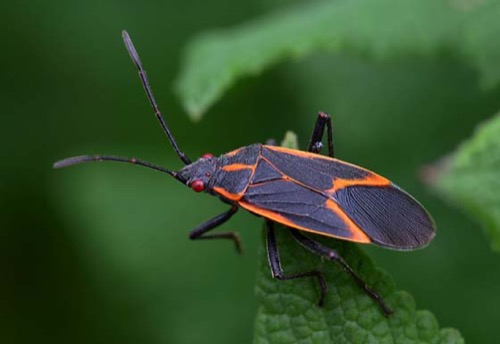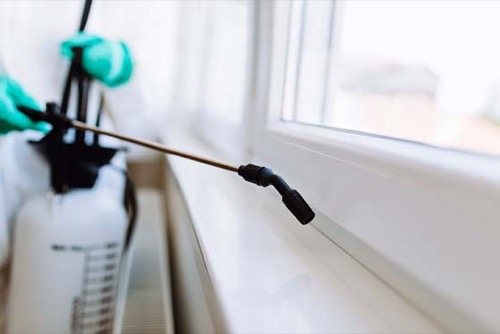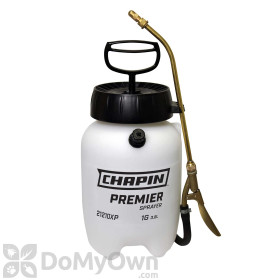
Asian lady beetles, boxelder bugs, cluster flies, and stink bugs are insects that share one thing in common: they're all overwintering pests. Overwintering pests seek shelter in homes, offices, barns, and other warm shelters during the winter to survive the cold weather.
Overwintering pests typically aren't a problem in the winter, as they will find hiding spots in the home and stay put. Homeowners will not usually see overwintering pests inside until the temperatures warm and the insects emerge from their hiding spots in search of food.
The best way to treat for overwintering pests is to prevent them from entering your home in the first place. But if they do enter your home, there are ways you can control the infestation. Below is a step-by-step guide on how to treat for and prevent overwintering pests. We also have guides specific to each type of overwintering pest that contain more specific identification, inspection, treatment, and prevention information. Read on to learn more.
Types of Overwintering Pests
Asian Lady Beetles

Ladybugs are generally harmless bugs that can actually be beneficial to gardens as they eat insects that feed on flowers and plants. But if they become trapped inside the home, Asian Lady Beetles, a species of ladybug, can leave behind a stinky, sticky substance on the walls of the home.
Read our guide on What Asian Lady Beetles Look Like to identify these pests.
Read our guide on Where Asian Lady Beetles Hide to find them in and around your home.
Read our guide on How to Get Rid of Asian Lady Beetles for advice on treating for these pests.
Read our guide on How to Prevent Asian Lady Beetles to stop Asian Lady Beetles from entering your home.
Boxelder Bugs

Boxelder bugs do not bite but they do leave a staining dye behind if crushed. A large amount of boxelder bugs in the home can be a nuisance, especially when they emerge from their hiding spots as temperatures warm outside.
Read our guide on What Boxelder Bugs Look Like to identify these pests before treating.
Read our guide on Where Boxelder Bugs Hide to know where to look for boxelders in and around your home.
Read our guide on How to Get Rid of Boxelder Bugs to remove boxelders from your home.
Read our guide on How to Prevent Boxelder Bugs to stop boxelder bugs from entering your home.
Cluster Flies

Like their name implies, cluster flies swarm and "cluster" around windows on warm days when they try to escape the homes they hid in to weather out the winter. Though harmless, cluster flies can be annoying, especially in large numbers.
Read our guide on What Cluster Flies Look Like to identify these pests.
Read our guide on Where to Find Cluster Flies to find them in and around your home.
Read our guide on How to Get Rid of Cluster Flies for advice on treating for these pests.
Read our guide on How to Prevent Cluster Flies to stop cluster flies from entering your home before winter.
Stink Bugs

Stink bugs, also known as shield bugs, do not sting or bite, but they do stink! As their name suggests, stink bugs release a strong odor as a defense mechanism, making an infestation unpleasant for homeowners.
Read our guide on What Stink Bugs Look Like to identify these pests.
Read our guide on Where Stink Bugs Hide to find stink bugs in and around your home.
Read our guide on How to Get Rid of Stink Bugs to treat for stink bugs.
Read our guide on How to Prevent Stink Bugs to learn how to prevent stink bugs from entering your home in the future.
How to Treat for Overwintering Pests
Treat Your Home with Insecticides
We recommend two different applications of insecticides around your home to combat overwintering pests. Liquid insecticides and dust insecticides work together to kill overwintering pests in different ways.
DoMyOwn created an Overwintering Pest Kit to make it easy for homeowners to combat overwintering pests. Each kit contains a liquid insecticide, an insecticide dust, and a hand bellow duster.
Read below to learn how to use each part of the Overwintering Pest Kit. The kit can be used to treat for Asian lady beetles, boxelder bugs, and stink bugs. Read our cluster fly treatment guide for information on treating cluster flies.
Products needed for Step 1
Use an Insecticide Indoors and Outside

Before the first frost of the year, you will want to treat both the inside and outside of your home with a liquid insecticide labeled for overwintering pests, such as Temprid FX. Mix the insecticide with water in a sprayer according to the directions on the label and spray the following areas around the outside of the home:
- Spray 1 foot up and 1 foot out from the foundation of the home around the entire perimeter of the structure
- On the sunniest side of the house, spray up to 10 feet up onto the side of the house. The sunniest side of the house is where overwintering pests will harbor before they move inside. Read the label of your insecticide to determine how high you can spray.
- Spray in cracks and crevices around the home's foundation
- Spray around door and window frames
- Spray where caulking around doors and windows has opened up
- Spray around vents leading outside
- Spray around outdoor light fixtures
- Spray in soffits, eaves, and vents
- Spray where utility pipes and wires enter the home

Inside the home, you can use the insecticide spray to spot treat. Do not blanket spray a room or carpet with your insecticide spray! Instead, focus on these areas inside the home:
- Spray around door and window frames
- Spray where utility pipes enter the home
- Spray beneath appliances and beneath sinks
- Spray around baseboards
Keep pets and children away from areas being sprayed until the insecticide spray has dried (1-2 hours).
Products needed for Step 1A
Use Insecticide Dust for Hard to Reach Areas

In addition to liquid insecticide, we recommend using an insecticide dust, such as EcoVia WD Insecticide Dust, around your home to combat overwintering pests in cracks, crevices, and other hard to reach places. Insecticide dusts are a slow kill, which is why they should be used with other faster working products, like liquid insecticides.
To use insecticide dust, select the dust of your choice. Fill a bellow hand duster half-way and dust in the following areas:
- Around door and window frames
- Where cables and pipes enter your home
- Around eaves and soffits
- In wall voids behind outlets
- In the corners of attics and closets
- In cracks and crevices around the home
- Underneath appliances
- Where pipes enter the wall
- Below sinks
Do not apply more than 1 or 2 puffs of dust per application area. Too much dust in one spot will repel insects, causing them to avoid areas where the dust has been applied, thus rendering the dust ineffective.
Some insecticide dusts are not labeled for outdoor use. Read the label of the dust of your choice to make sure it fits your needs.
Products needed for Step 1B
How to Prevent Overwintering Pests from Entering Your Home

To prevent overwintering pests from entering your home, follow Steps 1-3 above in the fall, before temperatures cool. In addition to those three steps, integrated pest management will assist in stopping pests from entering your home.
Integrated Pest Management is another name for the series of actions people can take to prevent the most common pests from entering their homes. Simple steps can go a long way in discouraging overwintering pests from entering the home.
Some basic steps include:
- Create a barrier zone by sweeping pine straw, mulch, or bark 6 inches away from the foundation of the home
- Add door sweeps to external doors
- Clean gutters to remove debris
- Add steel mesh to where utilities enter your home
- Add caulk to cracks and crevices around the home
- Repair torn window screens
- Keep your home clean
- Vacuum often to keep your home free of crumbs
Learn more about integrated pest management in our general pest prevention guide.









